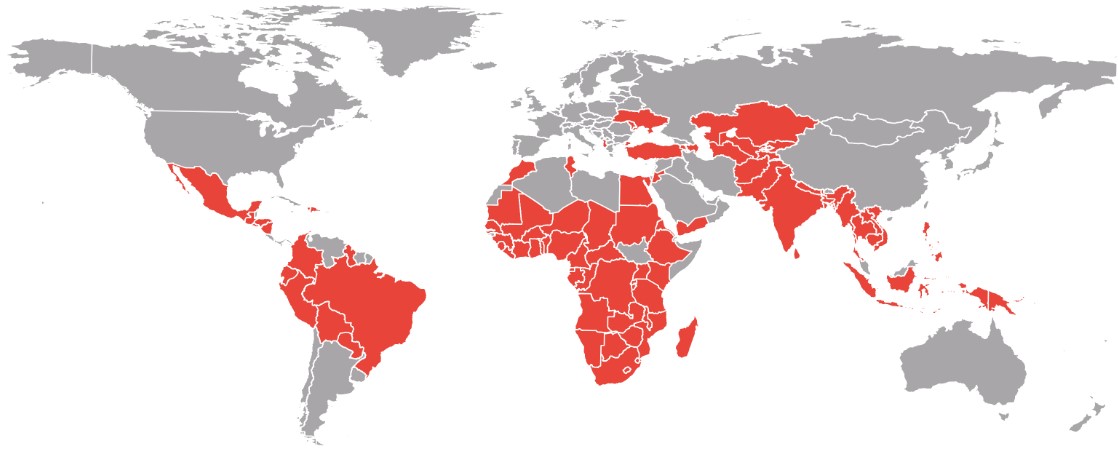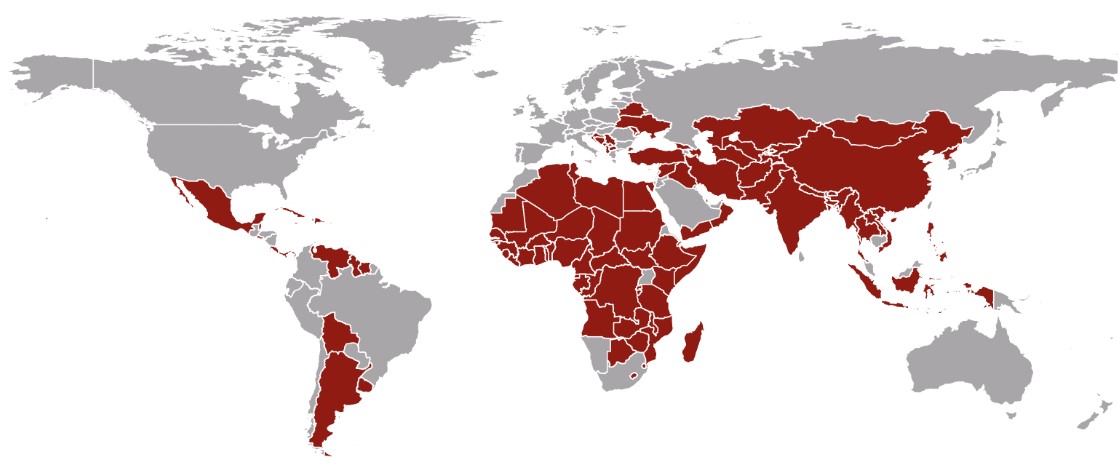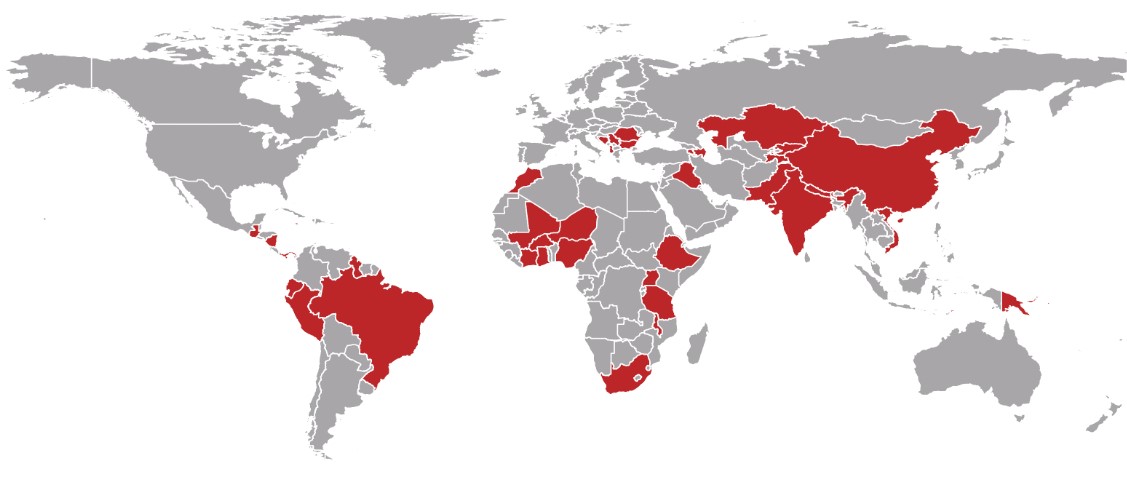- What are household surveys?
Household surveys are currently the most important data source for a range of key demographic and socioeconomic statistics for developing countries in which vital registration and administrative systems are lacking and the information gaps are largest. This will remain the case until better sources of data are available through credible, functioning and sustainable systems. There are three major international household survey programmes in use around the world.
Multiple Indicator Cluster Surveys (MICS)
The Multiple Indicator Cluster Surveys (MICS) is an international household survey programme developed by the United Nations Children’s Fund (UNICEF) in the 1990s. MICS was originally created to monitor the goals of the 1990 World Summit for Children.[1] Since then, close to 300 surveys have been carried out in over 100 countries.
Demographic and Health Surveys (DHS)
The Demographic and Health Survey (DHS) is a nationally-representative household survey developed by the United States Agency for International Development (USAID) in the 1980s. DHS built on previous work in the 1970s through the World Fertility Survey and Contraceptive Prevalence Surveys.[2] Since then, over 300 surveys have been carried out in just under 100 countries.
Living Standards Measurement Study (LSMS)
The Living Standards Measurement Study (LSMS) is a household survey developed by the Development Research Group at the World Bank in the 1980s. The programme is housed in the Survey Unit of the World Bank’s Development Data Group. Since the 1980s, over 100 surveys have been carried out in just under 40 countries.
- Who funds and supports household surveys?
- DHSs are funded and developed by USAID while their implementation is coordinated by ICF International, a strategic consulting firm, with support from other partners. USAID contributes around two-thirds of the funding and the rest comes from domestic sources.
- The MICS programme is developed and financially supported by UNICEF, with additional support from other UN agencies, development partners and governments. Government institutions typically fund and carry out the surveys themselves, with financial support from donors and technical assistance from UNICEF and its partners.
- The LSMS programme is financed, developed and implemented by national statistical offices in collaboration with the Word Bank, with the Bank providing technical assistance. LSMS and related surveys generally known as Household Income and Expenditure Surveys are highly customised between countries and their funding schemes can vary significantly. A recent component of the LSMS is its Integrated Surveys on Agriculture (LSMS-ISA). This has significant funding from the Bill & Melinda Gates Foundation. ISAs frequently include extensive questions on land ownership and crop yields.
Countries choose the survey (or surveys) they wish to implement based on their needs as well as availability of funding from domestic and external sources.
- How often are household surveys undertaken?
The DHS Program is carried out in phases, of which there have been seven to date, with phase one starting in 1984. The questionnaires have changed substantially between phases. Countries carry out a DHS survey on average every five years, but not all countries have done so every five years.
The MICS programme is carried out in rounds, of which there have been six to date. The first round began in 1995 and was carried out in over 60 countries and the sixth round began in 2016. Not all countries that have carried out a MICS survey have done so for each round.
A report published by the Global Partnership for Sustainable Development Data[3] recommends that similar surveys should be conducted every two to three years to track the Sustainable Development Goals.
- Where are surveys carried out?
Of the 130 countries that have carried out one of the three main household surveys, 67 have conducted more than one survey and 19 have carried out all three.
Figure 1: Countries that have carried out household surveys
DHSs, 1995–2016
MICSs, 1985–2016
LSMSs, 1995–2016
Source: Development Initiatives based on Demographic and Health Surveys (DHS), Multiple Indicator Cluster Survey (MICS) and Living Standards Measurement Studies (LSMS).
Notes: Country borders do not necessarily reflect Development Initiatives’ position. - What areas do they cover?
The household surveys are made up of a number of questionnaires, each of which is divided into modules that contain questions on a similar topic or theme. For DHS and MICS, there are different questionnaires for the household, women and men and questionnaires that measure biological well-being by measuring height, weight and other factors. Most standard DHS and MICS include a minimum of household and women’s surveys. Countries choose which modules to include to meet their needs. DHS and MICS also have some specialised modules and surveys that focus on specific populations or specific issues (such as malaria or HIV and AIDS).
Figure 2: Survey architecture
- How do the surveys compare?
Historically each survey had a purposeful origin: DHS monitored world fertility and contraception prevalence while MICS captured the status of children. Although each household survey contains unique, useful modules, as the surveys have evolved and worked together to harmonise common practices and associated tools – and due to country data needs – they have begun to resemble each other.
Previous research carried out by Development Initiatives found that two-thirds of the questions in the DHS and MICS surveys, the most widely used, are either identical or similar enough to be practically comparable;[4] 77% of all MICs questions can be found in DHS, and 66% of all DHS questions can be found in MICS.
Table 1: DHS and MICS question matches across questionnaires
Source: Analysis carried out by Development Initiatives as part of the Joined-up Data Standards project – see the discussion paper: Household surveys: do competing standards serve country needs?[5] Based on analysis between DHS-VII and MICS5.
However, data users needing to pull this data together for comparative analysis still face challenges. Although questions are duplicated across surveys, each survey follows its own coding standards for variables meaning duplicated questions cannot easily be matched. As a result, merging or comparing across datasets from different surveys to make a continuous data trend is both labour intensive and costly. Additionally, not only is the data coded differently between DHS and MICS, but data structures are substantially different between versions and rounds of the same survey.
In March 2015, the UN Statistical Commission endorsed establishing an Intersecretariat Working Group on Household Surveys to ‘foster coordination and harmonisation of household survey activities’.[6]
- What is the average sample size of the surveys?
There is considerable variation in the size of surveys. India’s 2015–16 DHS will include about 600,000 households while Samoa’s 2009 DHS includes 1,947 households. However, sample size can also vary within a country. Uganda’s four DHS surveys since 2010 have surveyed between 4,500 and 20,000 households. The sample size of a survey is determined by two dimensions. First, the number of subnational domains required for disaggregated reporting. Second, a calculation that works out the number of households required in each domain sample to reach the target population. What appears at first to be counterintuitive is that the sample size required for any country is not related to the total population of the country but rather to the number of domains (subnational divisions) chosen.
- How much does a household survey cost?
The cost of a survey depends on many factors such as the sample size of surveyed population; size of the survey (number of modules); population density; income level; and level of technical assistance required, which often depends on the statistical capacity of a given country.
Research from the Sustainable Development Solutions Network[7] estimated that among 77 of the countries receiving the most aid, the average cost per survey was US$1.6 million per DHS, US$1.0 million per MICS and US$1.7 million per LSMS-type survey.
- What are the data limitations?
To adequately sample the population, these surveys require accurate, current census information about the underlying population. Many countries do not have current census data and rely on biased information for sampling. Sampling also limits the extent to which data can be disaggregated. Most DHS and MICS surveys are only designed to represent a few subnational areas, limiting the ability of data users to provide rich disaggregated data beyond those levels.
Timeliness is another concern with these surveys. Analysing and cleaning the data can take up to two years after the survey has been completed. This could lead to the data being outdated before it is used extensively.
- What is not included in surveys?
By definition, household surveys include data on households. The definition of households can vary widely but this generally excludes people living on the street, in refugee or internally-displaced persons camps, in institutions such as prisons or orphanages,[8] and nomadic people.
In their current form, DHS and MICS are designed to focus on women of reproductive age (15–49) and children under 5. This means that relatively few questions are produced with these surveys for children between the ages of 5 and 15. Few questions are asked about men and few questions are asked about people older than 49.
- Annex - household surveys by country
Key facts on household surveys
An overview of the main international household surveys: what they are, when and where they're carried out, and what some of their data limitations are.
In this factsheet we provide an overview of the main international household surveys, laying out what they are, when and where they are carried out, and what some of their data limitations are. Download or use the menu below.
- What are household surveys?
- Who funds and supports household surveys?
- How often are household surveys undertaken?
- Where are surveys carried out?
- What areas do they cover?
- How do the surveys compare?
- What is the average sample size of the surveys?
- How much does a household survey cost?
- What are the data limitations?
- What is not included in surveys?
- Annex - household surveys by country
Notes
[1] UNICEF. A promise to children. Available at: https://www.unicef.org/wsc/
[2] Anderson, JE and Cleland, JG, 1984. The World Fertility Survey and Contraceptive Prevalence Surveys: A Comparison of Substantive Results. Studies in Family Planning. 15(1), pages 1–13. https://www.jstor.org/stable/1965479?seq=1#fndtn-page_scan_tab_contents
[3] Available at: http://opendatawatch.com/knowledge-partnership/state-of-development-data-funding-2016/
[4] Development Initiatives and Publish What You Fund (Lisowska, B), 2016. ‘Household surveys: do competing standards serve country needs?’ Available at: http://juds.joinedupdata.org/wp-content/uploads/2016/06/160628-Final-DP4-for-publication.pdf
[5] See note 4.
[6] Inter-secretariat Group on Household Surveys, see: https://unstats.un.org/iswghs/
[7] Sustainable Development Solutions Network, 2015. Data for Development: A Needs Assessment for SDG Monitoring and Statistical Capacity Development. Available at: http://unsdsn.org/wp-content/uploads/2015/04/Data-for-Development-Full-Report.pdf
[8] See Carr-Hill, R, 2013. Missing Millions and Measuring Development Progress. World Development. https://www.lidc.org.uk/sites/default/files/Missing%20millions.pdf
Related content
Donors at the triple nexus
DI Senior Policy & Engagement Advisor Sarah Dalrymple presents some of our recent analysis into how donors like Sweden and the UK are approaching the triple nexus between humanitarian, development and peace approaches in crisis contexts.
Implications of coronavirus on financing for sustainable development
DI Executive Director Harpinder Collacott summarises the possible impacts of the coronavirus pandemic on global development - including projections for extreme poverty, the future of different forms of financing, and the countries likely to be most impacted.
What do emerging trends in development finance mean for crisis actors?
DI's webinar ‘What do emerging trends in development finance mean for crisis actors?’ gives crisis actors key information on development finance to better understand what it means for them.





